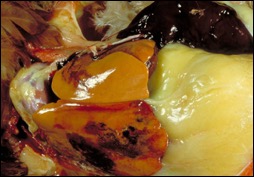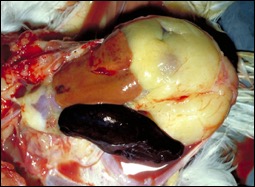Fatty Liver – Hemorrhagic Syndrome in a Chicken
Martin Ficken, DVM, PhD
A dead one-year-old female Red Sex-Link chicken was presented to the Texas A&M Veterinary Medical Diagnostic Laboratory in Gonzales, Texas for necropsy examination. Clinical history noted that it was found dead with no previous clinical illness noticed. The bird was fed an organic layer feed, vegetables, and fruit. History also noted the bird had no vaccinations or treatments and lived in a coop and run, i.e. not free range.
On necropsy examination, the bird weighed 2.35 kilograms and no external abnormalities were noted. Upon opening the coelomic cavity, a large blood clot was present overlying one liver lobe (Figure 1). The underlying liver had a rupture in its capsule which was the source of the blood clot (Figure 2). Numerous smaller blood clots were observed under the capsular surface of the other liver lobe. The liver was pale orange in color, was friable, and had a “greasy” texture (fatty liver).
The fat pad in the distal coelomic cavity was very large (Figures 1, 2) and the bird was in full production and had a shelled egg in the distal oviduct. No lesions were noted in any other tissue or organ system.
Following necropsy, fatty liver-hemorrhagic syndrome was determined to be the cause of death.
Fatty liver syndrome is a result of excessive consumption of high-energy diets, regardless of the source, in birds whose exercise is restricted. Also, the fat content of the liver normally increases with initiation of egg production that is influenced by estrogen. It is postulated that the excessive fat disrupts the architecture of the liver resulting in weakening of the reticular framework and blood vessels in the liver leading to the hemorrhage.
For more information about this case, contact Gonzales Resident Director Dr. Martin Ficken. To learn more about TVMDL’s test offerings, visit tvmdl.tamu.edu or call one of the agency’s four laboratories.
Reference:
Crespo, R, Shivaprasad, HL. Fatty Liver-Hemorrhagic Syndrome in Diseases of Poultry, 13th edition, Wiley-Blackwell, ed. Swayne, DE et al. pp. 1252-1253, 2013.

